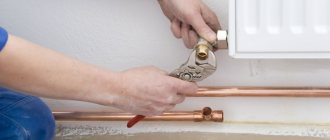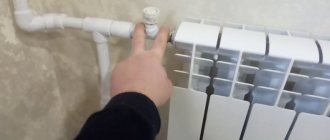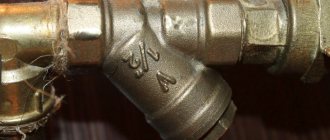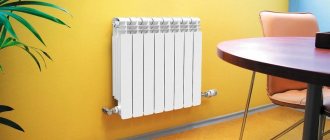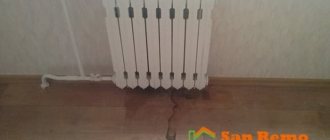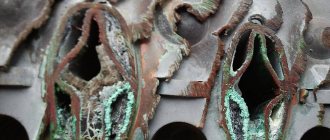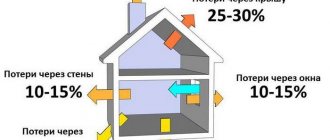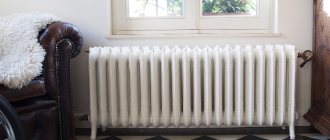Why do the batteries in the apartment not warm up well?
Reason 1: air locks
Often the radiators in the apartment are cold or not warm enough due to air locks. As a rule, this problem is relevant for residents of upper floors, since the air tends upward through the pipes. In order to eliminate air jams, a Mayevsky crane is used. It allows you to release the collected air and ensure full circulation of the coolant in the pipes.
Reason 2: non-optimal connection of heating batteries
The first sign of an incorrect connection is uneven heating of the battery. The radiator will not heat up enough if the water supply comes from below. In this case, it is best to change the connection diagram from the side or bottom to diagonal.
Reason 3: a large number of radiator sections
Uneven and weak heating of the radiator may be the result of too many sections. It is better not to allow the battery to be installed in more than 12 sections.
Reason 4: low coolant temperature
Sometimes batteries remain cold in winter due to the low temperature of the coolant itself (water). In this case, you must contact the house management.
Heat transfer from object to object
When 2 objects with different temperatures come into contact, heat will be transferred to the object with a lower temperature, which will gradually heat up, and the warmer object will cool down, giving up some of its heat.
How different heat leaks occur in the house:
- the walls give off heat to the foundation, and the foundation to the ground;
- walls, entrance doors and windows give off heat to the outside;
- ceilings give off some of the heat to the attic air;
- the roof gives off heat to the air outside (if there is attic heating);
- heat from the floor in the house is transferred to the air under the floor, the foundation and the soil.
The house loses most of its heat in such direct ways.
To prevent such direct heat transfers, materials with poor thermal conductivity (insulation) are used.
Why do batteries in a private house not warm up well?
Just as in the case of a high-rise building, there may be several reasons for the poor performance of heating batteries in a private house.
Reason 1: problems in the hydraulics of the heating system
The most common reason why radiators remain cold is due to the hydraulics of the heating system. In this case, one of the heating branches is working properly, and the second is intermittent. This picture is typical for a new heating system or when adding radiators to an existing one. If the hydraulics are incorrectly calculated, and in particular the diameters and lengths of pipes, some batteries may simply not heat up. You can adjust the hydraulics using special taps.
Reason 2: single-pipe heating system
In many private homes there are single-pipe heating systems. In such a system, batteries remote from the boiler often heat much worse than those nearby. This does not mean that there are problems; this is the nature of the operation of a single-pipe system. The only solution here can only be to replace the system with a two-pipe one.
Reason 3: boiler malfunction
The batteries may not warm up due to malfunctions in boilers with built-in automation, pumps and sensors, which is a typical problem for autonomous heating systems. In this case, you must contact a specialist who works with such equipment directly.
Convector batteries at home, which ones should I replace them with?
If it’s cold at home, which convector batteries should I change to? Sooner or later, many property owners who have heating convectors installed are faced with the fact that they stop heating. Then they have to be changed. What to replace with:
- Cast iron radiators. This is the oldest type of battery. They are inexpensive and durable, with a service life of more than 50 years.
- Aluminum. As the name suggests, these are radiators made entirely of aluminum. There are two types of them - injection and extrusion. They are best used for autonomous heating. They are not suitable for a centralized heating system due to pressure and corrosion caused by poor-quality coolant.
- Bimetallic. Such radiators consist of a tubular steel core and an aluminum surface. They are reliable and durable, but are quite expensive.
What to do if the bottom of the battery is colder than the top?
If the battery is hot on top and cold on the bottom, it is not functioning properly. In this case, diagnostics are required not only by the battery itself, but also by the entire heating system. The cause of the problem may lie in recent work on the heating system and replacement of the radiator. As a rule, the “hot top – cold bottom” problem appears due to an air lock (99% of cases) or a clogged radiator valve (a consequence of improper start-up of the system).
This problem is solved in two ways. You can remove the air lock using a Mayevsky tap or a bleeder. First of all, turn off the coolant supply to the radiator and leave the return line open. Open the drain, wait until the air comes out, close the drain and open the coolant supply. As a rule, this is enough.
If this method does not work, and we are talking about an apartment building, it is better to call a specialist. For private houses there is another option. First you need to turn off the heating supply, open the drain at the highest point of the system and use back pressure to squeeze out all the air.
Each heating system may have its own characteristics, and therefore there is a high probability of atypical problems arising. These include incorrectly selected pipe diameters, incorrect coolant distribution, poor throughput, lack of pressure, problems with the circulation pump or expansion tank. In any case, only a specialist can fully understand all the nuances, so in case of difficulties in solving the problem, it is better to seek help.
Causes of cold radiators
If, with the onset of cold weather and the heating season, heating is provided to your home, but the radiators do not work, then the problem may be a technical malfunction or the functioning of the entire supply system.
Especially if we are talking about a city apartment, the provision of heat in which should be handled by the housing and communal services service or another authorized body that checks the preparedness of the entire system for the heating season. Well, in the case of a private house, solving problems falls on your shoulders. If you wish, you can contact the Eurolux Group company; this company will carry out all the work quickly and inexpensively.
And here it is important to understand the main causes and individual problems that will need to be eliminated in order for the batteries to give off the maximum amount of heat.
The main factors that cause batteries to remain cold can be identified:
- presence of air pockets in the heating system;
- technical blockage of a single battery;
- incorrect connection of each of the elements and the entire system as a whole.
These criteria can affect the performance of both the individual battery and the overall system. Only after these problems have been eliminated will it be possible to talk about the full functional operation of the heating system in each room.
Let's consider each reason separately.
This is interesting! Heat-reflecting screen behind the radiator: how to install it yourself and the advantages of using it
Air jams
When studying the functional features and eliminating the problems of cold radiators and batteries, it is important to take care not only of one of them, but also to check the condition of the entire system. This type of solution requires testing for operability in the presence of air pockets in the system.
Traffic jams can occur due to the appearance of excess air during radiator operation. At the same time, if we are talking about a city house, then, as a rule, the upper floors of high-rise buildings suffer.
But this problem can be easily fixed. To do this, in modern batteries special valves are installed in the upper part, which allow the accumulated air to be removed, restoring the operation of the system.
Heating system clogged
If heating has already been turned on in the system, and you still have cold radiators, there is a possibility that the existing system elements are clogged. This can be either the deposition of the corrosive properties of the metal or the gradual accumulation of scale and large amounts of dirt on the walls of radiators.
To perform flushing efficiently and quickly, follow these recommendations:
- move furniture aside, remove curtains, cover the floor with cellophane or cloth to avoid damage;
- shut off the coolant supply using the shut-off valve. If it is not installed, remove the battery, unscrew it and pour the liquid into a basin;
- to clean the radiator, it must be moved to a bathtub, at the bottom of which it is recommended to place a wooden floor;
- Using a wrench, unscrew the end caps and allow the dirty liquid to flow out of the battery into the bath;
- pour water under pressure from a hose into the battery;
- If a crystalline blockage has formed, it should be cleaned using a special reagent. Through the use of a chemical formula and high-quality pressure in the system, it is possible to remove existing problem areas of scale and corrosion and obtain warm and fully functioning batteries again. You can also use a 70% solution of vinegar and water;
- pour the reagent or vinegar solution into the battery, close the seals and let it brew for 2 hours;
- Rinse the battery inside and outside under high pressure water, wipe the battery dry and install it on the bracket.
Sometimes such actions do not help and you have to buy a new battery.
Connection errors
Also, a separate point may be such a reason as incorrect connection of each element of the heating system. Sometimes the supply pipes with the coolant and the supplied liquid are fixed from below.
This does not allow the battery to gain maximum heat, and the upper areas may remain cold. In this case, it is necessary to reinstall the connection elements and release heat through the upper section of the supply pipes and connections.
Why is the last battery cold in a private house? Why are the batteries cold?
Airlock. If there is a valve, open it and release the bubbles. New batteries usually have valves installed. You can knock on the pipes and shake them to let the air out. Install a pump, it can push through. And it will heat up faster when you first turn it on.
If it is clogged, tap the pipe, especially at the junction with the main pipe and the supply and return pipes.
on Saturday I did it in 3 rooms and a kitchen.. everything came out fine
400 HP, these are batteries + work
in corner apartments they always put an additional radiator on the end wall; I myself live in the first one, but not in the corner one when I bought the apartment, there were double radiators since the house was built, initially I changed them “to my mind.” that is, I made a project. They came to me and calculated which ones to buy. Well, they are so thick and long. They heat up normally))) so according to the law, everything is possible, as I wrote.
cost of batteries, spare parts (spare parts cost about 15 lats (if copper)) + 25 for work + 10 for shutdown and this is all for one battery, if you want 2 multiply by 2 it took 3 hours
Call your friends. A person exhales almost 37 degrees. What is not a heater
You asked it anyway. No, the fact that I can now still see what’s going on behind the battery won’t make me any warmer!
Cold water is rigas udens. call them, they will send plumbers and tell you what to do
The supply temperature is controlled automatically in your heating unit. As a result, either the heating curve is incorrectly configured, or the outside temperature sensor is not working correctly, or the two-way controller is faulty. contact the building manager
Or someone at home secretly installed batteries of unrated capacity, with a large margin. Why is it that he has Tashkent at home, and everyone else in the house is freezing at 15-18 degrees?
What are the types of heat loss?
Let’s conditionally divide them into 2 types:
1. Natural – these are significant heat losses through the windows, roof and walls of the house. Even if your house is built perfectly, its roof and walls are sufficiently insulated, it will still lose some heat. It will not be possible to avoid such losses, but minimizing them is quite possible. How? Read on!
2. “Heat leaks” are heat losses that can be detected and completely eliminated. These heat losses can be identified independently, but only in those cases when the cracks actually begin to “siphon.” Of course, in modern country houses and cottages this happens extremely rarely. Most often, it is impossible to visually detect such leaks.
Any heated house can be compared to a chimney, when warm air comes out of it, and cold air tends to penetrate into the room. Due to the difference in pressure inside and outside the house, the same thing happens. Moreover, the “chimney” phenomenon occurs not only when windows or doors are open, but also when there are small cracks and cracks in the building that are invisible to the eye.
To clearly understand how heat leaves the house, let's first understand how heat transfer in space can occur. After all, in order for your home to become truly warm, you need to reliably block all escape routes for warm air.
So, let's look further at how exactly heat is lost.
Causes of heating problems
First you need to make sure that the heating is really turned on, and the heating system of the apartment receives coolant at the required temperature. In the absence of problems with the central network, the causes of cold radiators include:
- presence of air pockets in the system;
- clogged batteries;
- Incorrect connection of heating network elements.
In each situation, a certain amount of work will need to be done to make cold radiators hot.
Waterproofing a country house
Effective moisture protection is also necessary for every home. It includes a membrane of roofing felt, waterproofing or bicroelast between the frame wall and the plinth. If the base is thick relative to the wall, it is necessary to drain it to remove moisture. To avoid dampening of the insulation in the walls, it is necessary to provide an air layer for it with a thickness of at least 50 centimeters.
Remember that wet insulation loses its properties and is destroyed.
To protect the insulation from blowing, windproof material is used on the surface of the insulation located on the side of the air gap. And also “vents” are made in the upper and lower sections of the walls so that the air gap is ventilated.
Air jams
The most common cause of heating problems is air locks, which are formed due to a leak, rapid filling of the system, or as a result of heating the water. They appear especially often in apartments on the upper floors.
To make cold radiators hot, you need to remove air from the system. Modern models are equipped with special exhaust valves located at the top of the batteries and operating in automatic mode. Also, a Mayevsky valve or drain valve can be installed on the radiators, with the help of which air is removed manually.
The Mayevsky valve is a cone-shaped rod with a thread, when unscrewed, a through hole opens and the gaseous medium is removed from the coolant.
What to do if they are absent? If heating is turned on, but the radiators remain cold, you should contact the management company or the housing office and call a plumber to remove air from the system. Typically, a preventive check is carried out after supplying coolant to the system to prevent uneven heating.
How to eliminate uneven heat transfer
Not all problems can be solved on your own. Poor heat transfer from the radiator may be a consequence of non-compliance with the slopes, indicating gross violations in the installation of the heating system. In this case, you will have to invite a specialist in heating systems.
Some heating problems can be fixed on your own.
Air locks - air in the heating system is an inevitable consequence of filling pipes and radiators with coolant. A characteristic sign of the problem is that the radiator is warm at the bottom and cold at the top. If the section heats up unevenly, you can try to bleed air from the system using the Mayevsky valve. Some owners initially install an automatic air release valve.
Connection errors
Another reason why they may remain cold is incorrect connection of the heating system elements. The worst mistake is considered to be connecting radiators to pipes, in which water is supplied from below. In this case, the sections are heated unevenly, and part of it remains cold. This is most often typical for side connections. What should I do to ensure that the surface of the radiators heats up evenly and the apartment becomes warm? To do this, you need to correctly connect them to the system.
Too many sections can also contribute to uneven heating, since coolant circulation is difficult. A special extension cord connected to the pipe that supplies hot water to the battery will help improve it.
Advice! For uniform heating of radiators, the best option is a diagonal connection, which ensures maximum efficiency of the heating system.
System operation and maintenance
The mechanism that brings heat to apartments is multi-stage. Consequently, a separate organization is responsible for each section of the heating system. Inside the house, in accordance with the standards, the service organization inspects, repairs and evaluates the condition of utility networks:
- Management Company;
- housing cooperative;
- homeowners association.
As a rule, they hire a specialist to do this. He identifies and, if necessary, corrects equipment malfunctions, evaluates the quality of services and possible causes of excessive heat consumption. The inspection is usually carried out once a year and coincides with the start of commissioning of the system.
Heating system clogged
Batteries are often cold due to deposits on the inner walls of the case. The reason for their appearance is various impurities in the composition of the coolant and products of the interaction of hot water and metal. What to do in this case?
Cleaning radiators in an apartment is carried out in several ways, each of which requires certain equipment and conditions of execution.
If at the inlet and outlet of the coolant, then it is possible even with the heating running. To do this, the radiator is removed and the dirt is washed off with a strong stream of water. If unsuccessful, the sediment from the walls of the housing is removed using chemicals. After drying, the heating device is installed in its place, and the joints are carefully sealed.
It is possible to remove deposits from the walls of batteries without removing them. This is done using special equipment using the following methods:
- Chemical. It is carried out using solutions of organic and mineral acids, alkali and other compounds. It is produced using special equipment, consisting of a pump, a container for cleaning fluid and hoses. The method is indispensable for steel pipes.
- Hydropneumatic. Used when there is equipment that can create high pressure. Water is used as a cleaning liquid, due to which turbulent flows are formed that destroy deposits on the walls of pipes and radiators.
- Hydrodynamic. It is carried out with a jet of water under high pressure; the supply of liquid to hard-to-reach places is ensured through various nozzles. The cleaning method is effective for heating elements made of cast iron and is expensive.
- Pneumohydropulse. Suitable for batteries and pipes with a diameter of no more than 150 mm. Deposits are removed using a water pneumatic gun, which can act in a targeted manner.
As a result of a thorough study of the causes of uneven heating and proper elimination of it, cold radiators will become hot, and the living quarters will have a comfortable temperature.
After putting the central heating system into operation, it takes some time for it to come into operation.
How to clean clogged batteries
- To clean the radiator from debris and dirt, you will have to remove the device and wash it. Before starting the procedure, prepare the area for cleaning. It is better to clean radiators outside or in the bathroom;
- First cover the bathtub with a thick cloth and insert a protective mesh into the drain hole to avoid damage to the enamel surface of the plumbing fixtures and prevent clogging of the pipeline;
- Close the valves and unscrew the nuts, carefully drain the remaining water, remove the radiator and place it outside or in the bathroom;
- Tap each section with a hammer or mallet to help the rust and plaque fall off quickly. Then carefully shake out any accumulated debris from inside;
- For washing, use a special sealed hose to clean the battery under high pressure. Simply rinsing the device under the tap or in a basin will not clean it. Special cleaning agents can also be used along with water. To be effective, pour hot water into the radiator and leave for half an hour, and then rinse;
- If the radiator is severely clogged, most likely the other radiators are also clogged. In this case, you will have to wash each battery. Many bimetallic radiators are washed extremely rarely, so a large amount of solid particles and debris accumulates inside. In addition, plaque and rust may appear;
- When cleaning yourself, be careful, as you can easily get burned due to the hot coolant. It is better to entrust the work to specialists. If you want to do the procedure yourself, you will find useful tips and tricks in the article “How to clean a radiator.”
What to do if the apartment is cold?
If at the beginning or the height of the heating season one battery in the apartment or the entire circuit does not work, you must seek help from the organization that supplies the home with heat. To do this, just carefully read the payment receipt. She comes monthly. It must indicate:
- address of the heat supply organization;
- hotline or emergency service telephone number;
- if possible, the address of the organization’s website.
Using this data, it is easy to contact specialists and ask them for help if the heat is on but the batteries are cold.
Try bleeding the air, maybe that's the reason.
How soon should the issue of heating at home be resolved?
According to current legislation, the problem associated with insufficient heating at home must be resolved within the following time frame:
- within 16 hours if the room temperature is within +12°C;
- after 4 hours, if the air in the apartment has warmed up to +10°C.
For each hour exceeding the specified limit, payment for heat provided should be reduced by 10-15%, according to the current tariff. This applies to cases where the radiators in the apartment are not completely heated. What to do if radiators remain cold in a separate room or separate wiring? If it heats, but by half, then there will be no reduction in payment for the services provided. But at the same moment, the consumer has the right to call a specialist from the service organization to fix the breakdown.
Before the specialist arrives, it is necessary to establish that only in one of the rooms there is a cold radiator or the problem extends to the entire apartment, or maybe to the entire riser or entrance. The collected information will help the plumber quickly navigate the site and fix the breakdown as soon as possible.
Three way valve
Such a tap is required to switch the bypass-battery direction. If this is the reason that the radiator does not heat, then the problem can be eliminated in 3 ways:
- No disassembly. In cases where the tap turns easily, but switching does not occur at all (neither one nor the other works), you can try to develop the device using multiple turning movements. In this case, blockages, as a rule, are washed away by the flow, going into the riser. The operation of shut-off valves is restored in full.
- With partial disassembly. There's no way to turn the tap? We're not trying to break it. Carefully unscrew the locking screw of the handle, remove it, place the screw back in order to prevent deformation of the part during further work. Further actions are carried out with a wrench. It is not recommended to use round nose pliers, pliers, etc. The reason is the same as with the screw - not to damage the rod. Holding the rod with a wrench, we smoothly rock it back and forth, starting with minimal vibrations. If you cannot make minimal movements, slightly loosen the large hex nut that presses the stuffing box seal. If it starts to dig in, place a small container. Continuing the work, moving the rod, press the seal into place, turning the large nut back accordingly. We unscrew the screw, install the handle, screw in the screw, and rejoice.
- In rare cases, when the internal stop is simply torn off, the crane has the ability to “spun in a circle” endlessly - we simply select the position of the handle in which normal operation is ensured.
So that the apartment is always warm...
Many ordinary people are wondering if. First of all, you need to inform the company that provides the house with heat. It is its specialists who are obliged to repair the heating circuit as soon as possible. In some cases, utility payments are overrun.
Radiators in the house may be cold due to air in the system, accumulation of dirt in it, low coolant flow, or improper installation of the heating circuit. Only a specialist can correctly determine the nature of the breakdown, and therefore correctly eliminate it. It is prohibited to carry out any adjustment work independently. The question is discussed in more detail in the video:
A cold radiator at the height of the heating season is far from uncommon. This kind of trouble happens not only in an apartment, but also in your own home.
All batteries are hot at the top, but colder at the bottom. However, when the temperature difference is very large, this indicates a problem. After all, the radiator emits much less heat than planned.
Demand what you paid for
Heating of apartment buildings is a service provided by heat suppliers and every consumer has the right to demand high-quality performance . If you silently wait out the frost with the heaters on, then you pay twice - for heating and for the electricity used for heating. Therefore, do not waste your money - in case of violation, seek recalculation and normal temperature in the apartment.
When cold weather sets in, heating appliances must be turned on in every house or apartment.
And if we are talking about central heating or an existing private boiler with a water heater mechanism and installed radiators, then a logical question arises: how to make the radiators warm.
Sometimes it is not enough to simply turn on the heating and the existing boiler in the house, because there are a large number of problems and nuances that prevent the radiators from becoming warm.
The metal remains cold until the problem of all supplied heat or a particular criterion is eliminated.
Problems with the radiators themselves
Why is the radiator hot on top and cold on the bottom and how to fix it?
The bottom of the battery is clogged with dirt
- At first in my apartment
. When they are warm, ask your neighbors. - When everything is in order with them and with the heating wiring, as well as with the radiators, it means that the problem is in your device.
- Most often, the reason is that it is clogged with dirt
- metal oxides (rust) and other suspended matter, which, when settled, do not allow the coolant to pass through. Therefore, the top of the radiator is hot and the bottom is cold. - Try warming up the battery in the problem area
. The water will boil there, begin to move, and perhaps the suspension will leave.
Note! Of course, a more effective way to clean the battery is to remove it and wash it. However, you cannot do this work yourself, because... you will have to disconnect the entire heating riser from the water. Housing office workers will refuse to do this in the winter cold. Therefore, the batteries should be washed in advance, before the start of the heating season.
Air in heating devices
Often batteries do not heat well, because... an air plug was created in them. It is formed when the coolant heats up and suddenly fills the heating system with it.
When the radiator is equipped with a release valve, it is not difficult to deal with the problem yourself.
- On modern types of batteries, this device is mounted at the top and functions autonomously, periodically bleeding off excess air.
- Manual valves are also often used. They should be unscrewed and kept in this state until water begins to flow.
- Old battery models do not have taps. But there is a stub.
- Place a basin under the radiator to prevent water from spilling onto the floors. Unscrew the plug until a hissing sound appears. Wait until all the air has escaped and water begins to ooze out. Next, screw the plug back on.
Incorrect installation of heating system elements
The following types of heating pipe connections are now common: diagonal analogue, bottom connection, side installation.
- The instructions now consider the diagonal type of connection to be the most effective.
- The connection is not correct when the coolant supply branch is connected to the bottom of the batteries. Then hot water flows in the lower part of the heating device and does not fully warm it up. Installing a water inflow extension can correct the situation here.
- Lateral connection is also ineffective. Then only the initial sections of the radiators warm up sufficiently, at most 4/6. In this situation, qualified plumbers will be able to help you.
Note! It is very common for the radiators on the top floors of apartment buildings to be hot, but downstairs they are lukewarm. Here the problem is obvious - illiterate design and installation of the heating system. You can’t handle this on your own; you will need to consult an independent heating engineer.
It should be noted that the number of sections in any type of heating system should not exceed the standard limit.
- When heating by gravity (gravity) the radiator should not have more than 12 sections.
- In forced circulation systems, heating devices should not be composed of more than 24 sections. Otherwise, the last of them will still not warm up.
The main reasons for this phenomenon
The problem of “cold bottom” (let’s call it that) is faced not only by those whose system is equipped with fairly old heat exchangers, but also by people who have installed bimetallic heating radiators. There are many reasons why this problem occurs, so it is difficult to immediately say why the batteries do not warm up evenly enough. Typically, each specific case should be considered individually. So, let's try to figure out the main reasons for this malfunction.
Reason #1. Normal blockage
The very first (because the most common) reason for this phenomenon is contamination of heating radiators. Here are the main reasons for the temperature decrease in the lower part of the device:
- low-quality coolant is used;
- air has entered the system.
It is worth noting that the working fluid can contain not only heat, but also various solid particles. For example, when the heating season begins, and centralized lines are just starting up, the quality of the working fluid is, to put it mildly, disgusting. Things are much better in the case of an individual heating circuit - contamination can penetrate into it only through an open expansion chamber.
This is all clear, but how can the temperature difference be affected by the presence of air in the system? The explanation for this is very unusual - bacteria are to blame. There is a certain variety of such microorganisms that can exist only in the presence of a sufficient amount of oxygen. Such bacteria are known as anaerobic. There is nothing wrong with them, but their waste products settle at the bottom of the heating radiator in the form of sediment.
Note! It is also worth noting that the working fluid brings sludge into the battery from almost the entire heating line, and it settles there.
Finally, another reason that the bottom of the battery is cold and the top is hot can be considered the special design of the heat exchanger. The liquid moves in it, permanently changing the vector of its own motion. And inside the heat exchanger there is a fairly large number of “secluded places” in which dirt can be deposited.
Video - Cleaning the heating radiator
This reason is more or less clear, so let’s move on to the next one.
Reason #2. Problems with shut-off valves
Sometimes the reason why the temperature of the lower part of the radiator is lower than the upper part can be due to the shut-off valves. In previous articles we have already examined the design features of such reinforcement, so today we will only briefly consider a few main points. The main purpose of shut-off valves in the heating circuit is to regulate, as well as completely/partially block the movement of the working fluid.
The fittings can be the following mechanisms.
- Ball valve.
- Thermal head, which is equipped with mechanical or electronic control.
- Cone valve.
But what does the decrease in temperature at the bottom of the radiator have to do with it, you ask? The fact is that as a result of problems with shut-off valves, the circulation of the working fluid inside the heat exchanger is disrupted. After all, the tap may simply become unusable, which is why the coolant will not flow even in its open position. This, for example, could be a failed damper or any other mechanism failure. It is also worth adding that the correct installation of shut-off valves also plays a very important role in this case.
Note! All taps of this type have an arrow indicating in which direction the working fluid must move in order for the heating line to function normally.
And if the tap is installed incorrectly, then one way or another the movement of the coolant will be disrupted: in this case, it will not matter whether the damper mentioned above is closed or open. We also note that for some types of shut-off valves there are requirements regarding the position in which the valve itself should be located relative to the space. For this reason, in case of problems with the uniform heating of heating devices, the shut-off valves should also be inspected.
Thermostat for heating radiator
Previously, we talked about the types, applications and technical characteristics of thermostats for heating radiators; in addition to this article, we advise you to read this information and read about it here
Reason #3. There is not enough pressure in the system
Low pressure in the line can lead to disruptions in the circulation of the working fluid, as a result of which it may happen that the bottom of the battery is cold and the top is hot. What to do in this case? First, you should make sure that everything is normal with the pressure in the network. As you remember, not so long ago - and we are talking about the times of the Soviet Union - batteries made of cast iron were widely used. They differed in that they had fairly wide passages, therefore, in order for the working fluid to pass through the entire heat exchanger, not so much pressure was required. But modern heating radiators have a slightly different structure.
Quite often, even immediately after purchasing such batteries, people encounter a problem when the upper part has a much higher temperature. This is explained by the fact that the output and inlet pipes, as well as the labyrinth of the heat exchanger itself, have a small nominal bore. For this reason, in the line, which was originally designed for cast iron, the pressure is simply unable to overcome the resistance and “push” the working fluid through the entire heat exchanger.
In addition, the pressure in the heating line may drop for other reasons; let’s take a look at them.
- The neighbors secretly equipped the apartment with a “warm floor” system that runs on water and is connected to centralized high-temperature heating.
- Certain problems arose on the highway itself.
- The same neighbors equipped their bypass with a tap.
- Again, the neighbors significantly increased the volume of the heat exchanger, equipping it with several additional sections.
- Finally, the same people living next door are experimenting with regulating their own heating radiators.
As you can see, often a sudden drop in pressure is associated with some actions of neighbors. As for the extended radiators, the volume of the heat exchanger in which exceeds that of the developer, and the “warm floor” system, it should be noted that all this is contrary to the law. All these manipulations lead to the fact that the pressure in the line decreases, so you shouldn’t even be surprised by the fact that the lower part of the batteries in your house will be cold.
Illiterate arrangement of an autonomous heating system
When arranging heating in your home, the question often arises as to why the last radiators in a two-pipe system are cold.
Why do batteries heat poorly in a private home?
In this case, the batteries may be cold from below, when the “return” and “supply” have been confused, or the coolant circulation rate inside the devices is not high enough.
- In the first case, everything is simple. The battery was incorrectly connected to the supply and return pipes of the heating system. Here it is enough to disconnect the radiator and connect it correctly, according to the heating diagram.
- When the radiator is hot at the top and cold at the bottom in the second case, it is explained as follows. When the coolant flows through the system at high speed, its elements will be hot everywhere. When the speed is low, the water gradually cools and becomes colder at the bottom of the radiators.
Conclusion
Ineffective operation of a heating radiator can be caused by completely different factors. First of all, you should understand what the cause of the problems is and only then try to eliminate them. The video in this article is also devoted to this topic.
Very often on thematic forums the question of why the last battery is cold is discussed. This applies to both the heating circuit of a private house and the distribution of centralized heat supply in multi-apartment buildings. A situation may also arise when the heating element does not heat while being in the middle of the wiring. It is impossible to answer such questions unambiguously. After all, there can be many reasons for such a situation. Also read: “Why is half of the radiator cold?”
Where to complain if the problem is not solved
If the management company has not taken measures to eliminate cold batteries, then all that remains is to write a complaint to higher authorities.
Complaint to Rospotrebnadzor
The Rospotrebnadzor department is designed to deal with problems related to the supply of low-quality services.
The practice of contacting Rospotrebnadzor shows that after a utility consumer contacts this body, the problem will be resolved in a short time.
State Housing Inspectorate
After a tenant is dissatisfied with the work performed and the inaction of the management company, he has the right to appeal to a higher authority - the State Housing Inspectorate.
Specialists will visit the apartments again and repeat the measurements. Then investigations will be carried out with housing and communal services and, as a result, the problem will be eliminated in a short time.
Sample of a collective complaint against the Criminal Code to the Housing Inspectorate.
Local body of the Federal Antimonopoly Service
The Federal Antimonopoly Service (we are talking about monopolistic suppliers of utilities: Vodokanal, etc.) influences the management company.
This service monitors the provision of services. Therefore, there is a high probability that after visiting this body, the process of considering the complaint will be accelerated.
The same applies to repair work to eliminate violations in the apartment.
Read our article about how to write a statement to the prosecutor’s office against the Criminal Code.
Visiting city and municipal authorities
The current head of a city, region or district can influence the consideration of the issue of cold batteries.
He has the power to bring violators to justice. However, the problem lies in the permanent employment of the official.
If the head of a city or district receives a collective appeal from citizens, then the problem will be solved faster.
Sample complaint against the Criminal Code to a local government body.
Prosecutor's office
The prosecutor's office is called upon to solve the problems of disadvantaged consumers. Its representatives will conduct an investigation into the complaint received.
When applying, you will need to provide a copy of the application with which the owner applied to the management company, as well as a heating inspection report, which was previously certified by an engineer.
Global heating circuit problems
Kote doesn't like cold batteries.
The reasons why one battery is hot and another is cold can be global in nature:
- the bypass is installed incorrectly;
- no balancing;
- insufficient pressure.
The bypass is not installed correctly. The bypass is a tube in front of the radiator. It connects the supply of heated coolant and the return. The last battery does not heat well if the bypass is installed too far from it. After all, according to the laws of physics, it will be easier for the coolant to pass through the bypass than through the entire heating element.
The bypass taps directly into the wiring, rather than through a two- or three-way valve. The coolant enters the radiator through outlets. As a result, the cross-section of the supply pipes decreases. There is not enough pressure in the system to push hot water through the circuit. As a result, the last heating radiator does not heat.
Often, when the heating circuit is first started, the last battery in the house does not heat. What to do? Experts recommend not taking radical actions and allowing the system to level out. The air that is in the water must come out naturally. After some time, the heating wiring will function normally.
Error in bypass circuit.
Incorrect installation of the radiator. Why doesn't the last battery heat up? The last radiator in the heating circuit may be too large. It contains more than 12 sections. In this case, the pressure in the system is not enough to drive the coolant through the entire volume of the heating element. The situation is aggravated by the lateral connection. Hot water does not reach the outer sections. As a result, the last heating radiator does not heat well.
Incorrect balancing. Balancing the system means uniform distribution of the coolant throughout the entire heating circuit. It is performed using shut-off and control valves and thermostats. If the last battery in the heating system is cold, then perhaps the problem lies in the uneven distribution of hot water throughout the wiring.
Everything about plastic pipes for heating: characteristics, dimensions, installation.
What thickness should steel pipes be for heating? The answer is here.
The role of return and its difference from supply
Sometimes, when carrying out plumbing work on their own, the user does not know how to identify the supply and return pipes when the battery is connected. If you are completely unfamiliar with the design, you can use a thermometer, identifying the supply and return pipelines by the temperature difference, if you know the circuits for discharging coolant to the heating radiators, consider the following options:
- With diagonal and side switching, the supply is always at the top and the outlet at the bottom.
- In the lower connection, the direction of movement of the input and output flows is sometimes indicated by arrows on the supply unit (binoculars).
- In Leningradka, the return pipe is considered to be the one coming from the last radiator in the row.
- In the manifold distribution, the supply combs are equipped with adjustable supply sensors in the form of fittings with transparent caps and indicators placed inside; the shut-off valves of the return comb are closed with threaded plugs. Also, the color marking of the forward feed is red, and the return feed is blue.
Rice. 3 Organization of heating systems using an open expansion tank
The return line plays no less important role than the direct line for supplying media to heat exchange devices or heated floors, its purpose and installation methods:
In gravity flow structures with an open storage tank. The movement of water in open circuits occurs due to the difference in hydrostatic pressures of the cooled and hot water columns due to the fact that the hot liquid has a lower density.
Therefore, the return line is designed and installed taking into account the following rules:
- Heat loss in the return must be quite significant to minimize the cooling of the water, that is, the batteries must have significant heat transfer.
- As the distance from the bottom point of the radiators to the boiler inlet pipes increases, the length of the low-temperature column increases and, accordingly, it more effectively displaces the heated coolant. The high location of the boiler from the battery lengthens the section with a cooled return, while simultaneously shortening the section of the high-temperature column - as a result, a large temperature difference shifts the working fluid much further up the circuit and heating occurs more efficiently.
- The upper installation of the boiler is contradicted by the condition under which it must be at a height below the level of the last batteries in the chain for the gravity flow of the carrier into it at an angle. If the boiler is installed low in the basement, to ensure normal circulation during installation, slopes towards the heating unit should be observed (2 - 3 mm per linear meter).
It should be noted that both of the above schemes are working (the latter is used more often) and their choice is related to the convenience of installing boiler equipment in the house.
Rice. 4 Closed heating system - diagram
In closed circuits with an electric pump. In multi-circuit heating with heated floors, circular pumps are installed that create the required pressure in the main; in many cases, two circular pumps are used - one pumps water throughout the system, and the second supplies coolant to the floors or radiator heaters.
With collector wiring, the return temperature relative to the supply plays an important role; the difference should not exceed 10º C, standard differences are 55 - 45, 50 - 40, 45 - 35, 40 - 30 degrees. To achieve these parameters, the cooled coolant from the return manifold is partially mixed with the hot coolant coming from the boiler, and then supplied to the heated floors.
In boiler piping. When the boilers are put into operation, the initial difference between the supply and return temperatures is quite significant - this leads to the formation of condensation on the walls of the heating chamber and chimney pipes, which, entering into a chemical reaction with carbon dioxide and other combustion products, causes accelerated corrosion of their surface.
To prevent these negative consequences, a small circuit is created with an adjustable check valve, in which the temperatures of the coolant entering the boiler and the heated fluid are quickly equalized. After reaching the specified temperature threshold, the thermal valve automatically opens and the entire system line is connected to the small heating circuit.
Sometimes, to equalize the temperature parameters of the supply and return, a bypass jumper of small diameter is installed between them; the width of its passage channel can be adjusted with screw valves (ball valves are used only for completely closing and opening passages).
Local causes of heating system failure
The last battery is too long.
Why is one battery hot and the other cold? Experts cite the following reasons for this situation:
- airing of the system;
- low quality coolant;
- poor quality heating element.
In most cases, the above problems can be resolved by homeowners themselves. However, the help of a specialist is never superfluous.
Today, cross-linked polyethylene pipes are most often used for heating.
Find out whether it is possible to paint heating pipes made of plastic here.
Airing the system. Air may accumulate in individual elements of the heating system. This phenomenon is called circuit airing.
Air can get into the wiring:
- from an open expansion tank;
- if ordinary tap water was used as a coolant. It contains a certain percentage of dissolved air;
- the aggressive coolant environment oxidizes the walls of aluminum radiators. As a result, oxygen is released. It accumulates inside, forming a plug.
It is easy to determine whether there is an air lock inside the heating equipment. To do this, you need to simultaneously turn off the taps on the supply and return pipes, and then open them in complete silence. If there is extraneous noise and gurgling inside the device when the tap is opened, there is an air lock there. This is the main reason why one battery is cold and the rest are hot.
This video will help you remove air jams:
Debris and rust in the heating circuit can also explain why your last radiator is cold. Foreign objects block the flow of hot water, thereby reducing the efficiency of heating the house.
Design features of the gas boiler Baxi baxi, Navien, Ariston
In any case, it will be useful to become familiar with the equipment of this class and the features of modern models. This knowledge will help you choose the right equipment and avoid making mistakes during operation.
In household boilers Baxi (baxi), Navien and Ariston, gas, diesel and solid fuel are burned to heat water, and electric heating elements are used. To more fully utilize the potential of energy resources, heat exchangers are being improved. They make long ducts of complex shapes to ensure that the liquid remains in the working area for a long time.
The current trend is compactness. Manufacturers offer gas boilers with square bodies of relatively small thickness. Some models, due to their aesthetic characteristics, deserve to be placed in a prominent place.
The next feature is the introduction of automated control systems. They control the combustion process, change operating modes taking into account the readings of temperature sensors on the street and in individual rooms. If the equipment overheats, it turns off without user intervention.
It is necessary to carefully consider situations when the Baxi gas boiler does not heat the water. This happens, for example, when the supply of energy resources is cut off. It is not difficult to carry out an appropriate check even without special professional training.
Circulation pumps, valves, and other typical components and assemblies rarely fail. Their designs are designed for many years of operation without mandatory maintenance. Electronic circuits have no moving parts at all. Their breakdowns occur due to defects. Subject to the rules established by the manufacturer, the service life of modern gas heating boilers is more than 10 years.
Voltage surges in the power supply network can damage the electrical part of the equipment. To eliminate such influences, an external stabilizer is installed. It will be useful to check the grounding system. This completes the set of preventive measures for this group of problems.
It is much more difficult to provide protection against the most common cause of breakdowns of gas boilers - scale.
It is this that will be studied in detail in this article. When heated, calcium and magnesium salts are converted to a solid state. It is these impurities that clog narrow technological openings in heat exchangers. They also form a porous structure on the surface of electric heating elements. If normal heat dissipation is significantly disrupted, their housings are damaged.
To prevent the formation of scale and lime inside the boiler, it is advisable to install non-chemical filters (water converters), magnetic and electromagnetic, which will ensure a long “life” of your boiler and an uninterrupted supply of hot water, as well as protect the heating circuit.
Why don't the batteries heat up?
You have noticed that the last battery in the home heating circuit is cold. What to do? Experts advise first determining the nature of the breakdown. It can be both global and local in nature. In the first case, you need to pay attention to the correct installation of the bypass and the heating element itself. The breakdown can be eliminated only by redoing the heating wiring in the house.
Local breakdowns include air pockets and contamination inside the heating element. They are the main reason why the middle or last battery in the heating system is cold. These problems can be fixed by a person without professional skills. But the help of specialists will not hurt here.
Boilers with automatic ignition.
Water circulation in the heating circuit is disrupted.
Due to the slow movement of the coolant in the heating system, the water in the heat exchanger overheats and the boiler stops in emergency mode. The speed of fluid movement in the system can be affected by decreased performance or breakdown of the pump, contamination of the filter installed on the “return” of the heating circuit, or improper operation of the three-way valve.
The performance of the circulation pump is reduced due to contamination of the turbine blades or internal cavity.
Photo 1 – circulation pump module of a gas boiler with automatic ignition.
To revise it you need:
- Stop smoothly by moving the water temperature regulator knob to the extreme zero position and wait until the process is completed, turn off the power to the boiler.
- Remove the front part of the housing.
- Determine the installation location of the pump.
- Close the shut-off valve (No. 2, No. 3, No. 4 photo 2) of the supply, return, and cold water supply lines.
- Drain water from the boiler through the drain valve and leave it in the open position.
- Loosen the pump fasteners until air enters the circuit to drain residual fluid from the system.
- Remove the mount, power plug and remove the module (engine with turbine).
- Clean the blades, internal cavity and rubber seal of the mechanism from dirt.
- Assemble the pump.
- Open the cold water supply tap.
- Open the feed tap slightly to check the tightness of the hydraulic part of the boiler.
- Open the flow and return valve.
- Fill the system with water to a pressure of 1 bar.
- Turn on the boiler in circulation mode to remove air.
Photo 2 is an example of heating system pipe routing.
In boilers with electronic control, if the pump breaks down, the corresponding fault code will be displayed on the dashboard, which is deciphered using the boiler passport or electronic catalogs posted on the manufacturer’s website.
Checking and cleaning the filter:
- Smoothly stop the boiler.
- Using the taps (No. 1, No. 2) installed in front of and behind the filter, turn off the water supply.
- Using the filter drain valve, remove water from the isolated area.
- Unscrew the flask and clean the mesh catcher.
- Assemble all filter components.
- Open previously closed valves.
- If system pressure decreases, recharge the circuit.
- Turn the boiler to the venting position.
Checking the three-way valve.
In double-circuit wall-mounted gas boilers, switching from the heating mode to the hot water supply position is carried out using a three-way valve. It consists of a servo drive (motor with gearbox), rod, rubber seals, valve and body with inlets and outlets. A malfunction of this device can lead to a cessation of coolant circulation and, as a result, overheating of the heat exchanger occurs.
To check the condition of the three-way valve, it is necessary to smoothly stop the boiler and de-energize the system. Check the serviceability of the engine, and to do this, connect ohmmeter probes to the power terminals. If it shows 80 - 300 Ohms, then the engine is working, and if there are other readings (0 or 1), then it is faulty.
The three-way valve may not switch due to jamming of the drive gearbox, or due to deformation of the valve itself. If malfunctions of the valve are detected, it is replaced with a serviceable one or undergoes revision.

